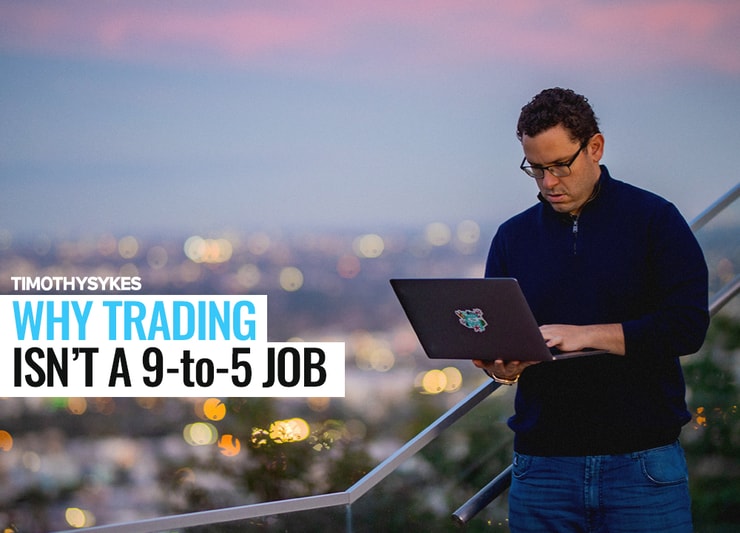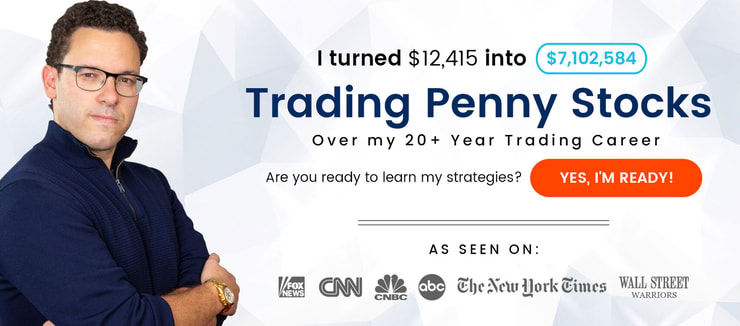Is a 9-to-5 job your worst nightmare? Today I want to talk about how you can get out of the 9-to-5 mindset. And why trading isn’t a 9-to-5 job…
So many people complain about their full-time jobs. You slave away all day at a job you don’t love for a boss who doesn’t appreciate you. Sadly, you’re not alone. More than half of Americans report they’re unhappy with their jobs.
Screw building anyone else's dreams but yours, don't beg the government or any company to support you, learn skills so you can support yourself, your family & anyone else too as there's SO MUCH $ in becoming an expert in whatever subject you love the most…it's fun & rewarding!
— Timothy Sykes (@timothysykes) April 16, 2020
Now’s the time to change that. The entire world is sheltering in place and economies are paralyzed. Use this time to find work you enjoy. Learn how you can turn a passion into a career.
The nationwide quarantine is a once-in-a-lifetime opportunity to improve your situation. Stop making excuses.
Ask yourself … How badly do you want to move beyond the 9-to-5 job norm?
My students want it more than anything. They put their entire lives on hold to become traders. They worked their butts off. So it’s no wonder several of them report breaking their single-month personal records.* They’re crushing this volatility.
What do these students have in common? They don’t trade from 9-to-5. Instead, they know…
Table of Contents
Studying Is a Full-Time Job

Study!
I can’t emphasize it enough. The top students in my Trading Challenge dedicate their lives to studying.
One of my top students, Tim Grittani, studied his butt off. He managed to turn his $1,500 trading account into over $10 million.* How?
He studied. A lot…
He found the strategies that work for him and honed in on them. His results blow me away. I’ve been trading for over 20 years and never seen anything like it.
Grittani started his trading journey years ago. Since then, I’ve created so much more content to help new traders. It can be overwhelming, but you can start with…
[*These results are far from typical. Always remember all trading is risky and never risk more than you can afford. These students dedicated time and effort to develop exceptional trading knowledge and skills.]
Your New 9-to-5 Job: Building Your Knowledge Account

As a trader, you have two accounts: your trading account and your knowledge account. You have to build your knowledge account before you start trading. Here are some resources…
Totally new to penny stocks? Access my FREE penny stock guide here.
You can get my book “An American Hedge Fund” for free. I explain my trading journey and what I learned from managing my own hedge fund. Then, move on to “The Complete Penny Stock Course” by my student Jamil to learn every penny stock pattern I teach.
I also have over 1,300 videos on YouTube and endless free content on this blog. But if you want a full trading education, you need to watch every lesson in my 6,300+ video library. Every day I make a new video lesson about the market conditions and highlight the best plays of the day. Make your education your new 9-to-5 job.
My newest millionaire student* watched every video three times. In case you’re wondering, it takes 1,500 hours to watch the entire video library three times. That’s dedication.
Want to better understand how to trade in a volatile market? Check out my newest NO-COST “Volatility Survival Guide.” It focuses on how to trade through the current market and the patterns that are working right now. The guide is about two hours, with trade examples and incredible lessons from StockstoTrade’s lead trainer Tim Bohen.
Next Level: The Trading Challenge
Still thirsty for more knowledge? Apply for my Trading Challenge. In addition to the video library, my Challenge students get three live webinars a week from my top students and me. You can be part of an incredible trading community.
Click here to apply today … but only if you’re ready to work.
My Trading Challenge is far more than a 9-to-5 job. How committed are you to building a better life? That’s what you have to decide.
To my knowledge, no one has ever watched all the content I have to offer. If you have, message me.
Sadly, I know most people only spend an hour or two studying and then treat the market as their own personal lockdown casino. No wonder 90% of traders lose.
The best traders study the past to understand the current market. Then they sit on the sidelines and only trade when setups fit their trading plans and strategies.
You don’t have to be handcuffed to your computer screens. That’s the beauty of trading. Leave the 9-to-5 job mindset behind and get into the…
Retired Trader Mindset
One of my favorite sayings is to act like you’re a retired trader.
I live a very busy life. Last year I traveled to over 30 countries helping Karmagawa build schools in developing countries. I don’t always have time to watch the market if there isn’t a good play. That’s why I make a daily watchlist.
👉 Get my FREE weekly stock watchlist here.
I wait until a play is so good, I have to come out of retirement because I can’t miss the opportunity. If there isn’t a good play, I enjoy life. Don’t force something that isn’t there.
Those are the only trades you should be taking. Ignore all the other noise and focus on good setups.
So, what’s a good setup? Well … that’s different for everyone.
Some people like buying breakouts … others like buying morning panics. There’s also buying the first green day. Then there’s shorting — the first red day, promotions, and overextended stocks.
More Breaking News
- Ambev S.A.: Is the Dip a Golden Opportunity or a Red Flag?
- BigBear.ai Stock Surges: What’s Driving the Gains?
- Is Grayscale Bitcoin Trust’s Recent Increase a Buying Signal or a Fade?
There isn’t one ‘right’ way to make money in the stock market. It depends on a lot of factors. A good setup is different for every trader.
Top Student’s Favorite Set-Ups

All my top students approach the market differently. They had to study and work to find their strategies and become self-sufficient traders.
My six-figure mentors Tim Lento reports closing in on $500,000 in profits.* He’s primarily a swing trader. When stocks go supernova, he shorts them with small size and holds them for weeks.
I’m not that patient, but the strategy works well for Lento — he doesn’t watch the market all day like he has a 9-to-5 job.
He trades only when his strategy presents itself. He’s patient until it fades to his price target. If he constantly watched his trades, he’d struggle to stick to his plan.
Learning to stick to your trade plan is what separates the good from the great traders.
Another student, Jack Kellogg (Jackaroo on Profit.ly), reported $800* on April 16 and called it a day by 11:02 a.m. Eastern.
In the Challenge chat, he said he had a good day and was leaving to keep his profits. I’m proud of his maturity in the last few months. He’s only 21 years old but trades and acts like a veteran trader.
Personally, I’m usually done after the morning session. I don’t like to stick around until midday because the opportunities disappear. I know what works for me, and I don’t let other people interfere with my trading plan.
If there isn’t a play, that’s fine. There’ll be one tomorrow or the day after.
By sticking to this mindset, I’ve locked in over $80,000 in profits so far this year.* All of which I’ll donate to charity.
(*Please note: these results are not typical. My students and I spent years developing exceptional trading skills and knowledge. Always remember trading is risky. Never risk more than you can afford.)
Small Gains Add Up
When you’re learning to trade, especially if you have a small account, you have to focus on two things … Cut your losses quickly and lock in singles.
Small gains add up.
I’ve made over $5 million trading stocks, but my average gain is only $1,754.*
Swinging for home runs is a time bomb. It’s only a matter of time before you blow up. And you’re likely learning the wrong lessons.
Use proper risk management. Don’t be greedy.
Understand the mentality of taking singles. I’m being real with you. That’s what I’m all about.
I could just brag about how I can make $2,000 in a day … but how does that help my students? Instead, I’m fully transparent. I let my students see every aspect of my trade.
I outline my risk levels and always state my trade goals. See for yourself — here are all my verified trades. Also…
You don’t need to trade with a huge account. Most of my students start with only a few thousand. Once they hit consistency, they slowly size up.
Take my recent Comstock Holding Companies Inc. (NASDAQ: CHCI) trade for example…
I spent $16,500 to buy 6,000 shares at $2.75. I sold at $3.10 for a little over 10% and locked in $2,100.*
$16,500 is a lot to some people, so reduce the size by 10. That’s 600 shares at $2.75 for $1,650. A 10% gain would be $200.
Again, the key to trading is locking in small gains — over and over.
(*Please note: my results are not typical. I’ve spent years developing exceptional skills and knowledge. Always remember trading is risky. Never risk more than you can afford.)
Trading Is Counterintuitive
The best traders in the world can pull in billions of dollars in a few short weeks. There’s so much upside potential IF you become the best.
But 99.9999% of you won’t be the best. I’m not the best — nor will I ever be.
As traders, we have to realize that and take the money where we can. Which is why I love penny stocks.
The competition is pathetic. If you take advantage of this lockdown and study your butt off, you can build your knowledge account. You can prepare. Don’t think about this like a 9-to-5 job where you take orders from a boss.
It's crazy to see so many sad unemployed people all of a sudden, I really wish they'd spend their #Quarantine studying as The Internet has SO MANY educational tools these days, there's no reason whatsoever to be so dependent on a job or anyone else for that matter, take control!
— Timothy Sykes (@timothysykes) April 16, 2020
You could study forex, options, or large-cap stocks … but you’ll have so much more competition.
Too many well-funded and highly educated traders are in those other niches. You’d be competing against the best of the best. Why would you do that to yourself?
It’s like playing basketball and going up against Michael Jordan. Why?
For your ego? Let me break the news to you now … if you go up against the best traders in the world, you’ll likely lose.
Meanwhile, my students are learning consistent patterns in a less competitive niche. Sure … making a few hundred might be laughable on Wall Street — but it’s good money to me.
The 9-to-5 Job Wrap
Trading isn’t a 9-to-5 job. I don’t want you to think of it as that kind of work. And I especially don’t want you to practice it as a full-time job.
Forcing yourself to trade all day will cause you to lose money. Instead, study the market like it’s your job. You can never be too prepared. You’ll never learn everything about the markets. Your education never ends.
And don’t come out of retirement until there’s an opportunity so good you can’t possibly ignore it. Find the patterns that work for you and only trade them.
Are you willing to do what it takes? I hope so. I’m always looking for more self-sufficient students. Apply for the Trading Challenge today.
Comment below if you promise to study your butt off to make the most of this lockdown! I love hearing from my dedicated readers.




Leave a reply